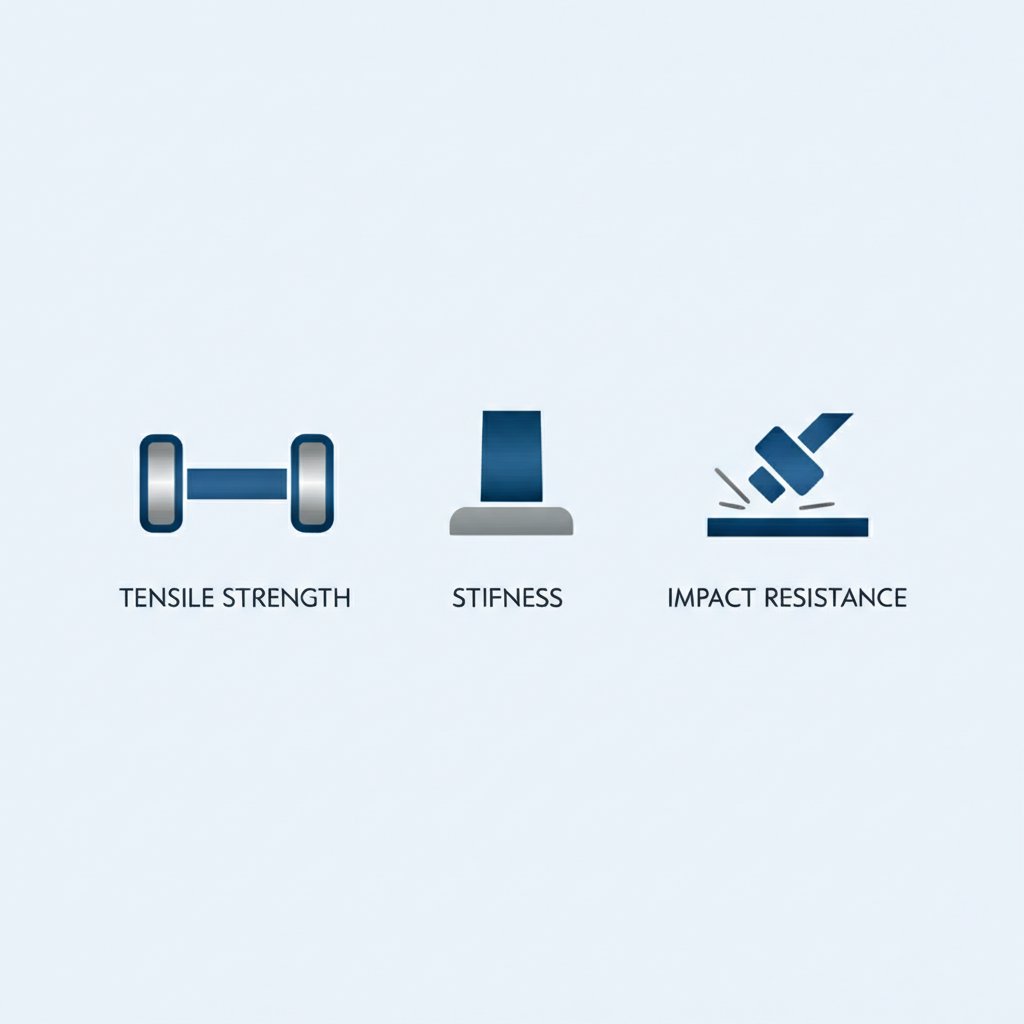Carbon Fiber vs. Aluminum: The Real Strength Showdown

TL;DR
Carbon fiber is stronger than aluminum in terms of tensile strength and stiffness-to-weight ratio, making it ideal for applications where high performance and low weight are critical. However, aluminum offers better impact resistance and fails more predictably by bending, whereas carbon fiber can shatter under sudden impact. The choice between them is a nuanced engineering decision based on specific needs for strength, durability, and cost.
Defining 'Strength': A Multi-Faceted Comparison
When asking if carbon fiber is stronger than aluminum, it's essential to understand that 'strength' isn't a single property. Engineers evaluate materials across several metrics to determine their suitability for a specific task. The most critical of these are tensile strength, stiffness (also known as rigidity or elastic modulus), and impact resistance. Each of these reveals a different aspect of a material's performance under stress, and in this context, carbon fiber and aluminum exhibit markedly different characteristics.
Tensile strength measures a material's ability to withstand being pulled apart. This is where carbon fiber truly excels. As a composite material, its woven carbon filaments bonded with resin create a structure with exceptionally high resistance to stretching forces. In contrast, aluminum, while strong, has a lower threshold before it begins to deform and eventually break. According to data from DragonPlate, carbon fiber can have a tensile strength of up to 1035 MPa, whereas 6061-T6 aluminum is rated around 310 MPa. This makes carbon fiber the superior choice for applications where tension is the primary force, such as in aircraft wings or high-performance bicycle frames.
Stiffness, or rigidity, refers to a material's ability to resist bending or deforming under a load. A stiffer material will flex less. Here again, carbon fiber holds a significant advantage. It has a stiffness-to-weight ratio about 1.7 times greater than aluminum. This property is crucial in applications that demand precision and minimal flex, such as in robotics, high-end automotive chassis, and scientific instruments. Aluminum is more prone to elastic deformation, which means it will bend more under the same load, a trait that can be either a drawback or a benefit depending on the design goal.
Impact resistance, or toughness, describes how a material handles sudden, forceful blows. This is an area where aluminum often has the upper hand. Its metallic crystalline structure allows it to absorb and dissipate impact energy by deforming—it dents and bends. Carbon fiber, being a brittle material, is more susceptible to cracking or shattering upon sharp impact. While it can withstand immense force along its intended lines of stress, an unexpected blow from the wrong direction can lead to catastrophic failure without warning. This makes aluminum a more forgiving material for components likely to face collisions or rough handling.
| Property | Carbon Fiber | Aluminum | Key Takeaway |
|---|---|---|---|
| Tensile Strength | Extremely high | Good | Carbon fiber is superior at resisting pulling forces. |
| Stiffness (Rigidity) | Very high (2-5x aluminum) | Moderate | Carbon fiber flexes significantly less under load. |
| Impact Resistance | Lower (brittle) | Higher (ductile) | Aluminum absorbs impacts by bending; carbon fiber can crack. |
The Strength-to-Weight Ratio: Why Lighter Can Be Stronger
While absolute strength is important, the true game-changer in modern engineering is the strength-to-weight ratio, also known as specific strength. This metric measures a material's strength in relation to its density. It answers the question: for the same amount of weight, which material is stronger? In this crucial comparison, carbon fiber has a decisive and significant advantage over aluminum and most other materials.
Carbon fiber's density is approximately 1.6 g/cm³, while aluminum's is around 2.7 g/cm³. This means carbon fiber is about 40% lighter than aluminum for the same volume. When you combine this low density with its high tensile strength, the result is a material that offers unparalleled performance per gram. According to comparative data, carbon fiber has a specific tensile strength approximately 3.8 times greater than that of aluminum. This means that a carbon fiber component can provide the same strength as an aluminum one for a fraction of the weight.
Think of it like comparing two athletes: a heavyweight powerlifter and a lightweight gymnast. The powerlifter might be able to lift more total weight (absolute strength), but the gymnast can lift their own body weight with an ease and efficiency that is far superior (specific strength). This is why carbon fiber is the material of choice in industries where minimizing weight is paramount, such as aerospace, Formula 1 racing, and competitive cycling. Reducing weight leads directly to better fuel efficiency, faster acceleration, and greater agility.

Beyond Strength: Durability, Failure Modes, and Cost
A comprehensive comparison extends beyond simple strength metrics to include real-world factors like durability, how a material fails, and its overall cost. These considerations often dictate the final material choice in a project. In terms of durability, carbon fiber offers excellent resistance to fatigue and corrosion. It can withstand repeated stress cycles without degrading and is immune to rust and other forms of chemical corrosion that can affect metals. Aluminum, while also corrosion-resistant due to its passivating oxide layer, is more susceptible to fatigue over time, which can lead to micro-cracks forming under cyclic loads.
However, the way these materials fail is drastically different. Aluminum is a ductile material, meaning it bends, deforms, and stretches before it breaks. This provides a visible warning of impending failure, which is a critical safety feature in many applications. Carbon fiber, in contrast, is brittle. It does not yield or deform under excessive load; instead, it fails suddenly and catastrophically by shattering or cracking. This abrupt failure mode requires engineers to design with larger safety margins to prevent unexpected breakages.
Cost is another significant differentiator. Carbon fiber is substantially more expensive than aluminum, often by a factor of fifteen times or more per pound. The manufacturing process for carbon fiber composites is complex, energy-intensive, and requires specialized labor and equipment. Aluminum, on the other hand, is one of the most abundant metals on Earth, and its production processes are mature and cost-effective. This makes aluminum the pragmatic choice for mass-produced goods and projects with tighter budgets where the extreme performance of carbon fiber is not a strict requirement.
Practical Applications: Choosing the Right Material for the Job
The technical differences between carbon fiber and aluminum directly inform where they are used. The choice is never about which material is universally "better," but which is best suited for a specific application's demands. The unique profiles of each material make them ideal for distinct and sometimes overlapping fields.
When to Choose Carbon Fiber
Carbon fiber is the premier choice when performance is the top priority and weight is a critical penalty. Its exceptional stiffness-to-weight and strength-to-weight ratios are indispensable in high-tech industries. Key applications include:
- Aerospace: Components for aircraft and spacecraft, such as wings, fuselages, and structural brackets, leverage carbon fiber to reduce weight, which in turn saves fuel and increases payload capacity.
- Motorsports: In Formula 1 and other high-end racing series, carbon fiber is used for the chassis (monocoque), body panels, and aerodynamic elements to maximize speed and safety.
- High-End Bicycles: Competitive cyclists prefer carbon fiber frames for their rigidity and low weight, which translates to more efficient power transfer and faster climbing.
- Medical Equipment: Components for prosthetic limbs and imaging equipment benefit from carbon fiber's light weight and radio-transparency (it doesn't interfere with X-rays).
When to Choose Aluminum
Aluminum remains a dominant material in countless industries due to its excellent balance of strength, low cost, and manufacturability. It is selected when impact resistance, ease of fabrication, and budget are primary concerns. Ideal applications include:
- General Automotive: Aluminum is widely used for engine blocks, wheels, chassis components, and body panels in consumer vehicles to reduce weight and improve fuel efficiency without the high cost of carbon fiber. For instance, in the automotive sector, where a balance of strength, weight, and manufacturability is key, companies like Shaoyi Metal Technology specialize in custom aluminum extrusions for precision components.
- Construction: Window frames, building facades, and structural elements use aluminum for its durability, resistance to corrosion, and light weight.
- Consumer Electronics: The casings of laptops, smartphones, and tablets are often made from machined aluminum for a premium feel, durability, and heat dissipation.
- Bicycle Frames: For most recreational and mid-range bicycles, aluminum frames offer a great combination of performance, durability, and affordability.
Frequently Asked Questions
1. Is carbon fiber the strongest metal?
This is a common misconception. Carbon fiber is not a metal; it is a composite material made from carbon filaments embedded in a polymer resin. While it is stronger than many metals, including steel and aluminum, in terms of its strength-to-weight ratio, it is fundamentally different from a metal in its structure and properties.
2. Does carbon fiber flex more than aluminum?
No, carbon fiber is significantly stiffer than aluminum. For the same dimensions, a carbon fiber component will flex much less under load than an aluminum one. The modulus of elasticity (a measure of stiffness) for carbon fiber can be up to nearly four times higher than that of aluminum, providing superior rigidity in high-performance applications where minimizing flex is crucial.
 Small batches, high standards. Our rapid prototyping service makes validation faster and easier —
Small batches, high standards. Our rapid prototyping service makes validation faster and easier — 
